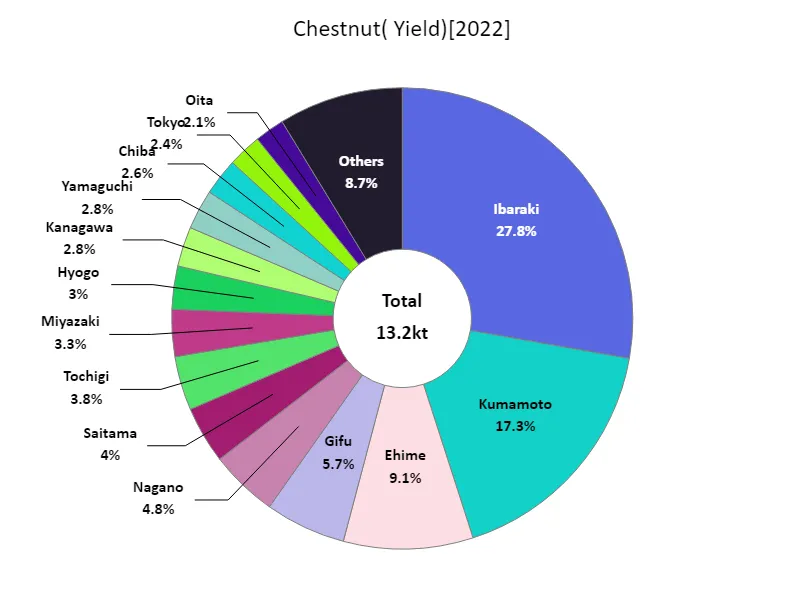Abstract
The latest data on harvest yields, bearing tree area, and shipping volumes in Japanese chestnut farming is based on 2022. The national harvest was 15.6kt, which remains at a relatively stable level. On the other hand, the fruiting tree area was 16.3 kha, which is a somewhat large area compared to the harvested amount. This suggests that efficient production techniques and management may be used in Japanese chestnut farming. Additionally, the largest shipment volume was from Ibaraki at 3.37kt, showing production differences between regions. Possible reasons for Ibaraki’s outstanding production include geographical conditions and advances in agricultural technology. Overall, chestnut farming in Japan can be said to have stable yields and an efficient production system in place, although production varies between regions.
Chestnut harvest volume (main data).
Harvest yields in Japanese chestnut farming have fluctuated when considering data from 1973 to 2022. If we take the national harvest peak of 65.3kt in 1979 as the benchmark, harvest volumes have been declining since then. The current yield is down to 23.9% of its peak. This decline is likely due to several factors. For example, there are urbanization, a decrease in farmland, and a decrease in the agricultural labor force. Other factors that may be contributing to the decline include changes in demand for chestnuts and the shift to other crops. However, it is possible that demand for chestnuts is increasing in certain regions or demand markets, which may explain the regional differences observed. Overall, chestnut farming in Japan is showing a declining harvest yield, but this may fluctuate depending on demand and regional characteristics.


The maximum is 65.3kt[1979] of Japan, and the current value is about 23.9%
Chestnut harvest volume (by prefecture).
Chestnut harvest volumes in Japanese agriculture are recorded by prefecture, according to the latest data for 2022. Among them, Ibaraki Prefecture boasts the largest harvest at 3.67kt. This indicates that Ibaraki is a major chestnut producing area. Ibaraki Prefecture may have an environment suitable for chestnut production due to factors such as its geographical conditions and advances in agricultural technology. Additionally, Ibaraki Prefecture had the largest harvest, suggesting that it has a more active chestnut production area than other regions. This suggests that Ibaraki Prefecture may be making good efforts in chestnut cultivation. In general, Ibaraki Prefecture is a major chestnut producing area in Japan and is characterized by maintaining high yields.


The maximum is 3.67kt of Ibaraki, the average is 601t, and the total is 13.2kt
Chestnut bearing tree area (main data).
The area of fruiting trees in Japanese chestnut farming has fluctuated when considering data from 1973 to 2022. At its peak nationwide in 1982, it reached 39.2 kha, but has been declining since then, currently standing at 41.6% of its peak. This decline is likely due to several factors. Urbanization, conversion of farmland, an aging agricultural population, and labor shortages are some of the factors that have been increasing their impact especially in recent years. Changes in agricultural policies and economic conditions may also be affecting the area of bearing trees. On the other hand, it is possible that demand for chestnuts is decreasing. Shifts in demand to other crops and changes in dietary habits may be affecting the area under chestnut production. In general, the area of fruiting trees in Japanese chestnut farming is on the decline, and changes in the agricultural environment and socio-economic situation are thought to be behind this.


The maximum is 39.2kha[1982] of Japan, and the current value is about 41.6%
Chestnut bearing tree area (by prefecture).
The latest data from 2022 on the area of bearing trees in Japanese chestnut farming is recorded by prefecture. Among these, Ibaraki Prefecture has the largest bearing tree area at 3.14kha. Ibaraki Prefecture has the largest area of fruiting trees, indicating that chestnut production is thriving there. Ibaraki Prefecture may have an environment suitable for chestnut cultivation due to its geographical conditions and advances in agricultural technology. Also, the largest area of fruiting trees suggests that Ibaraki Prefecture is a major chestnut producing area. This suggests that Ibaraki Prefecture may be making good efforts in chestnut production. At the same time, attention is also needed to see the state of fruiting tree area in other prefectures. There may be variations in the area of bearing trees due to local characteristics and changing demand. In general, chestnut production is thriving, especially in Ibaraki Prefecture, and the area of fruiting trees is expanding, but it can be said that various factors affect the area of fruiting trees in each region.


The maximum is 3.14kha of Ibaraki, the average is 617ha, and the total is 13.6kha
Chestnut shipping volume.
There are some noteworthy characteristics regarding shipment volumes from Japan’s chestnut farming industry in 2022. First, the largest overall shipment volume was from Ibaraki Prefecture, at 3.37kt, indicating that Ibaraki is the main chestnut producing area. Ibaraki Prefecture is believed to be able to maintain a high level of chestnut shipping volumes thanks to its efficient production system and favorable climatic conditions. On the other hand, the overall average shipping volume was 513t, which is a low level compared to Ibaraki Prefecture’s shipping volume. This indicates that chestnut production in other regions is not as high as that in Ibaraki Prefecture. Furthermore, the total overall shipment volume was 11.3kt, indicating that chestnut production in Japan as a whole is being maintained at a constant level. This suggests that chestnuts continue to have a certain importance in Japanese agriculture. However, it is also important to take into account the influence of various factors, such as regional differences in production and changes in demand. In general, chestnut production is thriving, especially in Ibaraki Prefecture, and it can be said that chestnut shipping volume throughout Japan is maintained at a constant level.


The maximum is 3.37kt of Ibaraki, the average is 513t, and the total is 11.3kt



Comments